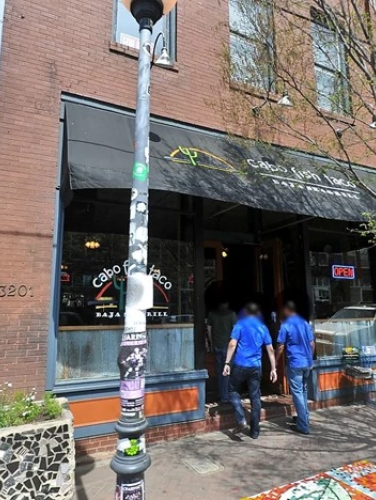
Hand's Pharmacy
(ca. 1912)
One of the first brick commercial buildings in North Charlotte, the Hand's Pharmacy building originally housed both a pharmacy and a community meeting place.
3201 N. Davidson St., Charlotte, NC 28205
The development of North Charlotte began in 1903, thanks to the expansion of textile manufacturing in Mecklenburg County from the 1880s to the 1920. Between 1903 and 1913, three new textile mills were built in North Charlotte: Highland Park Mill No. 3 (1903), Mecklenburg Mills (1905), and Johnston Mill (1913). Construction of Highland Park Mill No. 3 – the county's largest mill and one of the first mills in North Carolina designed to be run on electricity – was accompanied by the development of a large mill village that included houses, churches, a school and hotel, and a recreational park (formerly the grounds of the county poorhouse). A smaller mill village was built in conjunction with the Mecklenburg Mills.
Property Quick Links
As early as 1904, enterprising merchants hoping to cash in on the rapid industrial development in North Charlotte began opening businesses along the main road (Caldwell Street, now Davidson Street) between the present 34th and 36th Streets. Gaston County native Jasper Kennedy (J. K.) Hand (1878-1947), a graduate of Davidson College and the Pharmaceutical School at the University of North Carolina, and his wife Erwin (1881-1977) moved to the North Charlotte community in July 1907, where J. K. purchased Froneberger's Drug Store on North Caldwell Street. At that time, the business was in a wood-frame building located on the same side of the street and one block south of his later two-story brick pharmacy. In 1909, wanting a better and more permanent structure for his business, J. K. bought a corner lot on what was then the northeast corner of North Caldwell and 31st Streets. He hired local contractor Harvey C. Garrison some three years later to construct the building. By 1915, the Hands moved into a handsome one-year old house at 2900 Whiting Avenue.
The Hand’s Pharmacy building was twice as large as J. K. needed for his business, but he envisioned the second floor, with its separate outside stairway entrance, as a community meeting place for local men. But because other such facilities were available nearby, the second floor was mostly used for light storage, and, for many years, as an office for a local physician. Located entirely on the first floor, the pharmacy also included a marble soda fountain and several glass wall cabinets and display cases containing a wide variety of merchandise. For thirty-eight years, J. K. Hand provided service and merchandise for North Charlotteans through the ups and downs of two world wars, the Great Depression, and mill layoffs and strikes. In 1945, J. K. sold the business to John D. Dover, who had previously worked in the store. A few years later, it become Dorton's Drug Store, and finally the North Charlotte Pharmacy until 1978. Since that time, the building has housed various tenants, none of which have been related to the drug store business.
